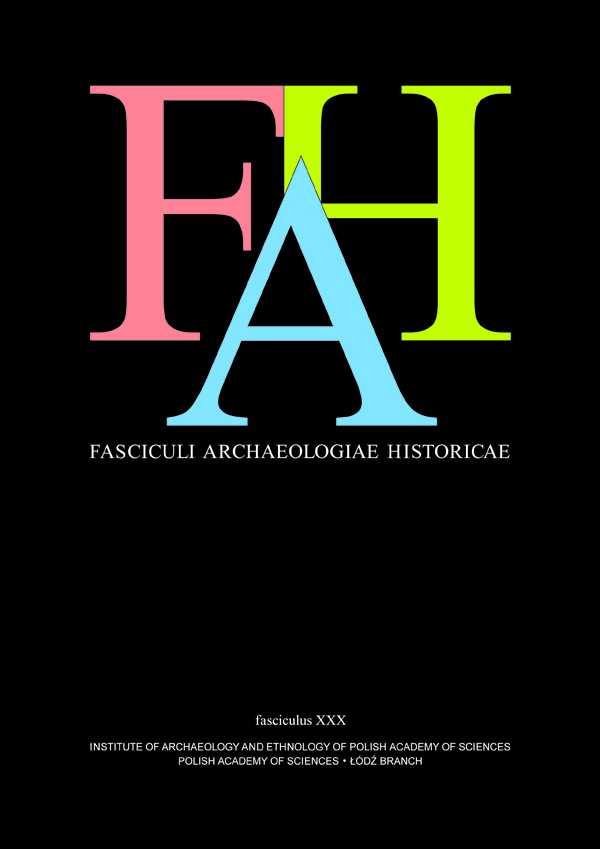Byzantine Weaponry and Military Equipment in the Homilies of St Gregory of Nazianzus (Paris, Gr. 510)
DOI:
https://doi.org/10.23858/FAH30.2017.013Keywords:
Homilies of St. Gregory of Nazianzus, Byzantine manuscripts, Byzantine weaponry and military equipment, shields, stirrupsAbstract
The author discusses illustrations presenting weaponry and military equipment in the famous manuscript of „The Homilies of St. Gregory of Nazianzus” (Paris, Bibliothèque Nationale, MS Gr. 510), completed in Constantinople in 879-882. Shields are usually of round or oval shapes. Basically, they are painted in red and much more rarely in blue. They are outlined by golden or blue stripes. Their decoration is difficult to determine but some geometric forms and simple wavy lines or vine branches can be seen. Shields of infantry soldiers are larger, with a diameter of about 1.00 m, while these of cavalry are smaller – about 0.50 m. With regard to swords, the author concludes that in some miniatures in the Homilies there are close parallels to already established type of Byzantine swords named „Garabonc Type” (five examples, dated to the 2nd half of the 9th c.). As regards images of stirrups in the Homilies, the author assumes that stirrups of a triangular shape – so-called Magyars stirrups, were familiar to masters of Byzantine miniatures. Additionally, arms and military equipment depicted in the Homilies offer support in determining some finds of weaponry which have been discovered either during regular excavations or incidentally.
Downloads
References
Baranov G. V./Баранов Г. В. 2017. Vizantijskij meč s teritorii Ukrainy. „Vojna i oružie” 1. Sankt Peterburg, 171-177/Византийский меч с територии Украины. „Война и оружие” 1. Санкт Петербург, 171-177.
Brubaker L. 1999. Vision and Meaning in Ninth-Century Byzantium: Image as Exegesis in the Homilies of Gregory of Nazianzus. Cambridge.
Catalogue 2008. The Arts of the Muslim Knight: The Furusiyya Art Foundation Collection. B. Mohamed (ed.), Milano, Skira, New York.
Catalogue 2010. Byzanz. Pracht und Alltag. Kunst- und Ausstattungshalle der Bundesrepublik Deutschland, Bonn, 26. Februar bis 13. Juni 2010, J. Frings (ed.), München.
D`Amatto R. 2015. East-Roman Helmets from the 9th to the 12th Centuries. „Acta Militaria Mediaevalia” 11, 27-157.
Dimitrov Hr./Димитров Хр. 1998. B’lgaro-ungarski otnošeniâ prez Srednovekovieto. Sofiâ/Българо-унгарски отношения през Средновековието. София.
Grotowski P. 2010. Arms and Armour of the Warrior Saints. Tradition and Innovation in Byzantine Iconography (843–1261). Leiden, Boston.
Jotov V./Йотов В. 2007. Otnosno datirovkata na sbornata nahodka ot Streževo, Bitolsko. „Problemi na prab’lgarskata istoria i kultura” 4 (2). Sofia, 171-180/Относно датировката на сборната находка от Стрежево, Битолско. „Проблеми на прабългарската история и култура” 4 (2). София, 171-180.
Kolias T. G. 1988. Byzantinische Waffen. Wien.
Langó P., Siklósi Zs. 2013. 10. századi temető Balatonújlak–Erdő-dűlőn. In: A honfoglalás kor kutatásának legújabb eredményei. Tanulmányok Kovács László 70. születésnapjára. Monográfiák a Szegedi Tudományegyetem Régészeti Tanszékéről 3, 143-160.
Schulze-Dörrlamm M. 1988. Untersuchungen zur Herkunft der Ungarn und zum Вeginn ihrer Landnahme im Karpatenbecken. „Jahrbuch des Römisch-Germanischen Zentralmuseums Mainz” 35 (2), 373-478.
Yotov V. 2011. A new Byzantine type of swords (7th–11th centuries). „Niš i Vizantija”/„Ниш и Византиjа” 9, 113-124.
Szőke B. M., Éry K., Müller R., Vándor L. 1992. Die Karolingerzeit im Unteren Zalatal. Gräberfelder und Siedlungsreste von Garabonc I-II und Zalaszabar-Dezsősziget. In: B. M. Szőke, Karolingerzeitliche Gräberfelder I-II von GaraboncÓfalu. „Antaeus” 21, 41-268.
Szőke B. M. 1994. Karoling-kori szolgálónépi temetkezések Mosaburg/Zalavár vonzáskörzetében: Garabonc-Ófalu I-II. „Zalai Múzeum” 5, 251-317.
Published
How to Cite
Issue
Section
License
Copyright (c) 2017 Fasciculi Archaeologiae Historicae

This work is licensed under a Creative Commons Attribution 4.0 International License.















